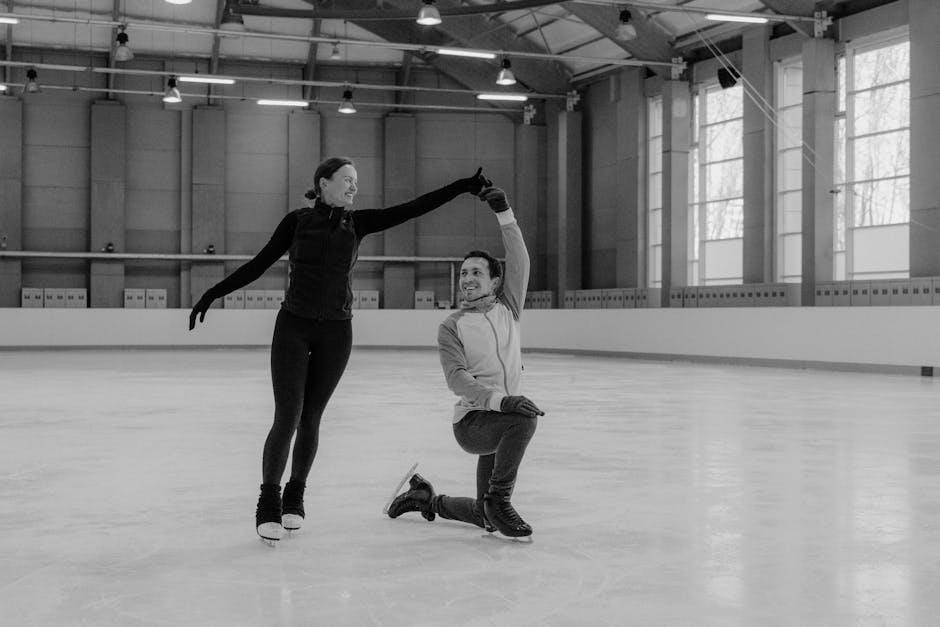Rotator cuff tendinitis is an inflammation of the tendons in the rotator cuff‚ causing pain and stiffness in the shoulder. It often results from repetitive movements or injury.
Exercises play a crucial role in managing symptoms and promoting recovery. Strengthening and stretching exercises can improve flexibility and strength‚ reducing the need for surgical intervention.
Understanding the condition and adopting proper exercises can help prevent further injury and enhance overall shoulder function. This guide provides a comprehensive approach to managing rotator cuff tendinitis effectively.
1.1. What is Rotator Cuff Tendinitis?
Rotator cuff tendinitis refers to inflammation of the tendons in the rotator cuff‚ a group of muscles and tendons that stabilize the shoulder joint. This condition often causes pain and stiffness‚ particularly with overhead movements or lifting. It can result from repetitive strain‚ injury‚ or degeneration over time. If left untreated‚ it may lead to chronic discomfort and limited mobility. Proper understanding of this condition is essential for effective management and recovery through targeted exercises and therapies.
1.2. Common Symptoms of Rotator Cuff Tendinitis
Common symptoms of rotator cuff tendinitis include shoulder pain‚ especially during overhead activities or lifting‚ and weakness when moving the arm. Stiffness and limited mobility are frequent complaints. Pain may worsen at night or with specific movements like reaching backward. Some individuals experience a dull ache that persists even at rest; If left untreated‚ these symptoms can progress‚ leading to significant discomfort and difficulty performing daily tasks. Early recognition of these signs is crucial for effective management and recovery.

The Role of Exercises in Treating Rotator Cuff Tendinitis
Exercises are a cornerstone in treating rotator cuff tendinitis‚ offering pain relief‚ improving mobility‚ and strengthening the shoulder muscles to prevent further injury and promote recovery.
2.1. How Exercises Help Alleviate Symptoms
Exercises for rotator cuff tendinitis are a key treatment method‚ helping to reduce pain and inflammation while improving shoulder mobility and strength. By targeting specific muscles‚ exercises can enhance blood flow‚ which aids in healing. Gentle stretching and strengthening movements restore range of motion and alleviate stiffness‚ making daily activities easier. Consistent exercise routines also strengthen the surrounding muscles‚ providing better support to the rotator cuff and reducing strain on the injured tendons. This approach not only manages symptoms but also supports long-term recovery and prevents further injury.
2.2. Importance of Consistency in Exercise Routine
Consistency in performing rotator cuff exercises is crucial for effective recovery. Regular exercises promote tendon healing‚ improve strength‚ and restore flexibility. Irregular or inconsistent routines can hinder progress and prolong recovery. Even if symptoms improve‚ stopping exercises too soon may lead to recurrence. Commitment to a daily routine ensures continuous strengthening and prevents further injury. Staying motivated and dedicated is essential for achieving long-term relief and full recovery from rotator cuff tendinitis.

Types of Exercises for Rotator Cuff Tendinitis
Types of exercises for rotator cuff tendinitis include stretching‚ strengthening‚ and isometric movements. These exercises improve shoulder mobility‚ enhance stability‚ and provide pain relief effectively.
3.1. Stretching Exercises for Shoulder Mobility
Stretching exercises are essential for improving shoulder mobility and reducing stiffness in rotator cuff tendinitis. They focus on enhancing flexibility in the shoulder muscles and tendons. Gentle stretches like the Cross-Body Stretch and Pendulum Swing help restore range of motion without straining the injured area. Regular stretching can alleviate tightness‚ promote healing‚ and prevent further injury. These exercises are often the first step in a rehabilitation program‚ laying the groundwork for more advanced strengthening routines. Consistency is key to achieving lasting improvements in shoulder function and comfort.
3.2. Strengthening Exercises for Shoulder Stability
Strengthening exercises are crucial for restoring shoulder stability in rotator cuff tendinitis. These exercises target the muscles around the shoulder‚ enhancing their endurance and strength. Examples include resistance band exercises and scapular wall slides‚ which help improve muscle balance. Strengthening not only supports the joint but also reduces the risk of future injuries. They should be performed with controlled movements to avoid aggravating the condition. Consistency in these exercises is vital for long-term shoulder health and functionality.
3.3. Isometric Exercises for Pain Relief
Isometric exercises are effective for pain relief in rotator cuff tendinitis‚ as they strengthen muscles without joint movement. These exercises‚ like isometric shoulder holds or wall push-ups‚ reduce strain on the rotator cuff while activating stabilizing muscles. Holding positions for extended periods (e.g.‚ 10-15 seconds) can alleviate pain and improve muscle endurance. They are ideal for early recovery stages‚ promoting strength and stability without exacerbating inflammation. Regular practice helps restore function and reduces discomfort‚ making them a cornerstone of rehabilitation plans.

Stretching Exercises for Rotator Cuff Tendinitis
Stretching exercises improve shoulder flexibility and reduce stiffness‚ aiding recovery. Gentle stretches like cross-body and pendulum swings are effective‚ promoting blood flow and easing tension without overexertion.
4.1. Pendulum Swings
Pendulum swings are a gentle‚ effective stretch for improving shoulder mobility and reducing stiffness. To perform‚ bend forward at the waist‚ letting the affected arm hang freely. Swing the arm in small circles‚ first clockwise and then counterclockwise‚ for 5-10 repetitions. Avoid forcing movement beyond a comfortable range. This exercise promotes blood flow and eases tension without overexertion‚ making it ideal for early stages of recovery. Perform 2-3 sets daily to enhance flexibility and reduce pain gradually.
4.2. Shoulder Extensor Stretches
Shoulder extensor stretches target the muscles at the back of the shoulder‚ improving flexibility and reducing tightness. To perform‚ stand in a doorway with arms extended overhead‚ hands on the doorframe. Gently lean forward‚ stretching the back of your shoulders. Hold for 20-30 seconds and repeat 2-3 times. This stretch helps alleviate tension and enhances range of motion‚ making it beneficial for rotator cuff tendinitis recovery. Perform daily for optimal results and to prevent stiffness.
4.3. Cross-Body Stretch
The cross-body stretch is an effective exercise for improving shoulder flexibility and reducing stiffness. Hold your affected arm at shoulder height and gently pull it across your chest with your other hand. Maintain a gentle stretch for 20-30 seconds‚ then release. Repeat 2-3 times daily. This stretch targets the rotator cuff muscles‚ enhancing mobility and alleviating tightness. Perform it slowly and avoid bouncing to prevent discomfort. Regular practice helps restore range of motion and supports recovery from tendinitis.

Strengthening Exercises for Rotator Cuff Tendinitis
Strengthening exercises are crucial for rotator cuff recovery‚ enhancing muscle strength‚ and improving shoulder stability. They target key muscles‚ promoting proper joint mechanics and reducing injury risk.
5.1. Isometric Internal Rotation
Isometric internal rotation strengthens the rotator cuff without joint movement‚ reducing strain. Stand with the affected arm bent at 90 degrees‚ palm facing away. Push hand against a wall or door frame for 5 seconds‚ then rest. Repeat 10-15 times in 3 sets daily. This exercise enhances shoulder stability and promotes healing by targeting the internal rotators‚ improving strength and control without risking further inflammation or damage to the tendons.
5.2. External Rotation with Resistance Band
External rotation with a resistance band targets the rotator cuff’s external rotators‚ enhancing strength and stability. Anchor the band at shoulder height. Hold the free end with the affected arm at your side‚ elbow bent at 90 degrees. Slowly rotate the arm outward‚ keeping the elbow close to the body‚ then return to the starting position. Perform 3 sets of 10-12 repetitions. This exercise improves shoulder mobility and strengthens the muscles‚ reducing the risk of further injury while promoting recovery and functional movement.
5.3. Scapular Wall Slides
Scapular wall slides strengthen the muscles that stabilize the shoulder blade‚ improving posture and reducing strain on the rotator cuff. Stand with your arms extended overhead‚ hands flat against a wall. Slowly slide your arms upward‚ keeping your hands in contact with the wall‚ then lower them back to the starting position. Perform 3 sets of 10-12 repetitions. This exercise enhances scapular mobility‚ reduces pain‚ and prevents further injury by promoting proper shoulder mechanics and alignment during daily activities and exercises.

Isometric Exercises for Rotator Cuff Tendinitis
Isometric exercises strengthen the rotator cuff without movement‚ reducing pain and improving stability. They are ideal for early recovery‚ as they minimize strain on injured tendons.
6.1. Isometric Shoulder Holds
Isometric shoulder holds are effective for strengthening the rotator cuff without movement. To perform‚ hold your arms at your sides‚ engage your shoulder muscles‚ and hold for 10-15 seconds. This exercise improves stability and reduces pain by targeting the deltoids and rotator cuff muscles. It’s low-impact‚ making it ideal for early-stage recovery. Perform 3 sets of 5-10 holds daily to enhance shoulder strength and endurance without putting excessive strain on the tendons.
6.2. Wall Push-Ups
Wall push-ups are a gentle‚ low-impact exercise for rotator cuff tendinitis. Stand facing a wall‚ place your hands shoulder-width apart‚ and slowly lower your body toward the wall‚ bending your elbows. Push back to the starting position without locking your elbows. This exercise strengthens shoulder muscles‚ improves posture‚ and reduces pain. Perform 3 sets of 8-12 repetitions daily‚ ensuring slow‚ controlled movements to avoid strain. It’s an excellent option for those with limited mobility or pain during overhead exercises.

Creating a Structured Exercise Plan
Creating a structured exercise plan is essential for effective recovery from rotator cuff tendinitis. It provides guidance on progression and balance between stretching and strengthening exercises.
7.1. Setting Realistic Goals for Recovery
Setting realistic goals for recovery is crucial when managing rotator cuff tendinitis. Goals should be specific‚ measurable‚ and achievable‚ focusing on pain reduction‚ improved mobility‚ and strength. Begin with short-term objectives‚ like performing daily exercises without pain‚ and gradually progress to long-term aims‚ such as returning to normal activities. Celebrate small milestones to stay motivated and adjust goals as recovery advances. This approach ensures a balanced and sustainable path toward healing.
7.2. Incorporating Exercises into Daily Routine
Incorporating exercises into your daily routine is essential for managing rotator cuff tendinitis. Start with short sessions‚ like 10-15 minutes‚ and gradually increase as the routine becomes a habit. Consistency is key; aim to perform exercises at the same time each day to build a sustainable routine. Track your progress to stay motivated and adjust the exercises as needed to avoid plateaus. This structured approach ensures steady improvement and long-term relief from symptoms over time.
Progression of Exercises Over Time
Progressing exercises gradually ensures continued improvement. Start with gentle movements‚ then increase resistance‚ intensity‚ and duration as strength and mobility improve over time.
8.1. Gradually Increasing Resistance
Gradually increasing resistance is crucial for strengthening the rotator cuff without causing further injury. Begin with low resistance using light weights or resistance bands. As strength improves‚ slowly add weight or tension. Monitor pain levels‚ ensuring exercises remain manageable. Avoid sudden increases to prevent setbacks; This progressive approach promotes tendon healing and enhances muscle endurance. Consistency and patience are key to rebuilding stability and function in the shoulder joint over time.
8.2. Enhancing Range of Motion
Enhancing range of motion is vital for restoring shoulder flexibility and reducing stiffness. Gentle exercises like pendulum swings and cross-body stretches help improve mobility without strain. Perform these exercises slowly‚ focusing on controlled movements within a pain-free range. Over time‚ gradually increase the depth of stretches as comfort allows. Consistency is key to preventing frozen shoulder and promoting natural shoulder mechanics. Regular practice can significantly improve functional mobility and reduce discomfort during daily activities‚ aiding in overall recovery and strength.

Preventing Further Injury
Preventing further injury involves avoiding overexertion‚ using proper lifting techniques‚ and incorporating supportive equipment. Prioritize controlled movements and avoid repetitive strain to protect the shoulder joint.
9.1. Proper Warm-Up Techniques
A proper warm-up is essential to prepare the shoulder muscles and reduce injury risk. Begin with 5-10 minutes of light cardio‚ such as brisk walking or cycling‚ to increase blood flow. Dynamic stretching‚ including arm circles‚ shoulder rolls‚ and side bends‚ helps improve flexibility and range of motion. Incorporate gentle resistance exercises‚ like light resistance band pulls‚ to activate the rotator cuff muscles. Avoid bouncing or forceful movements‚ focusing instead on controlled‚ smooth actions to safeguard the shoulder joint and promote a safe exercise routine.
9.2. Avoiding Overexertion
Avoiding overexertion is crucial to prevent further injury and promote healing. Listen to your body and stop if pain occurs. Avoid heavy lifting‚ repetitive overhead movements‚ or high-impact activities that strain the shoulder. Start with low resistance and gradually increase as strength improves. Focus on controlled‚ smooth movements rather than jerky or forceful actions. Rest between exercises and avoid overdoing repetitions. Prioritize quality over quantity to ensure safe and effective progress in your recovery journey without risking additional damage to the rotator cuff.
Treatment Approaches Beyond Exercises
Beyond exercises‚ treatment may include physical therapy‚ ice therapy‚ and anti-inflammatory medications. Rest and activity modification are also essential to support healing and prevent further irritation.
10.1. Physical Therapy for Rotator Cuff Tendinitis
Physical therapy is a cornerstone in treating rotator cuff tendinitis‚ focusing on improving shoulder mobility and strength. A licensed therapist creates personalized plans‚ often combining stretching‚ strengthening exercises‚ and manual techniques. Modalities like heat‚ ice‚ or ultrasound may be used to reduce pain and inflammation. Therapy aims to restore proper shoulder mechanics‚ enhance range of motion‚ and prevent future injuries. Regular sessions can significantly improve function and reduce discomfort‚ making it an essential complement to home exercises for effective recovery.
10.2; Lifestyle Modifications for Recovery
Lifestyle modifications play a crucial role in aiding recovery from rotator cuff tendinitis. Activities that aggravate the condition should be avoided‚ and proper rest is essential. Maintaining a healthy weight reduces strain on the shoulders‚ while good posture minimizes unnecessary stress. Smoking cessation and an anti-inflammatory diet can also promote healing. Modifying daily routines to avoid repetitive overhead movements or heavy lifting is vital. These changes‚ combined with exercise‚ create a holistic approach to recovery and prevent future flare-ups.

When to Seek Medical Help
Seek medical help if symptoms persist‚ worsen‚ or severely limit daily activities. Consult a doctor if pain intensifies or mobility significantly decreases despite exercise and rest.
11.1. Persistent Pain Despite Exercise
If pain persists or worsens despite regular exercise‚ it may indicate inadequate treatment or underlying structural issues. Consult a healthcare provider for a thorough evaluation to rule out partial tears or inflammation. They may recommend imaging‚ physical therapy‚ or alternative treatments like corticosteroid injections. Persistent pain can lead to chronic conditions‚ so timely medical intervention is crucial to prevent further damage and ensure proper healing.
11.2. Severe Weakness or Limited Mobility
Severe weakness or limited mobility in the shoulder may signal advanced rotator cuff damage or underlying conditions like tendon tears. If daily activities become significantly impaired‚ seek medical advice promptly. An orthopedic specialist can assess whether surgical intervention or advanced therapies are needed. Ignoring severe symptoms may lead to chronic instability‚ making recovery more challenging. Early intervention is critical to restore function and prevent long-term disability.
Downloading a Rotator Cuff Tendinitis Exercises PDF Guide
A rotator cuff tendinitis exercises PDF guide provides a structured‚ accessible plan for recovery‚ with detailed instructions and visuals to ensure proper form and progression.
12.1. Benefits of a Structured PDF Guide
A structured PDF guide offers a comprehensive and organized approach to managing rotator cuff tendinitis. It provides clear‚ step-by-step instructions for exercises‚ ensuring proper form and technique. The guide is easily accessible‚ allowing individuals to follow routines at home or while traveling. Visual aids‚ such as diagrams and images‚ enhance understanding. Additionally‚ a PDF guide serves as a convenient reference‚ enabling users to track progress and stay consistent with their rehabilitation plan. This resource is invaluable for promoting long-term recovery and shoulder health.
12.2. Finding Reliable Sources for Exercise Plans
When seeking a rotator cuff tendinitis exercises PDF‚ it’s crucial to prioritize reliable sources. Orthopedic websites‚ physical therapy clinics‚ and medical organizations often provide evidence-based guides. Look for resources endorsed by healthcare professionals or institutions. Peer-reviewed articles and reputable health platforms are excellent starting points. Ensure the PDF is updated and aligned with current medical practices. Avoid unverified sources that may offer inaccurate or unsafe exercises. Consulting with a doctor or physical therapist can also help identify trustworthy materials tailored to your specific needs.
13.1. Summary of Key Points
A rotator cuff tendinitis exercises PDF provides a comprehensive guide to managing symptoms and promoting recovery. It outlines stretching‚ strengthening‚ and isometric exercises tailored to improve shoulder mobility and stability. Consistency in performing these exercises is crucial for long-term relief. The guide emphasizes proper form‚ gradual progression‚ and avoiding overexertion. By following the structured plan‚ individuals can reduce pain‚ enhance strength‚ and prevent future injuries. Patience and adherence to the routine are essential for achieving optimal outcomes and restoring shoulder function effectively.
13.2. Final Thoughts on Exercise and Recovery
Exercise plays a vital role in managing rotator cuff tendinitis‚ fostering strength‚ mobility‚ and long-term relief. Consistency and patience are key‚ as recovery is a gradual process. Combining exercises with proper warm-up techniques and lifestyle adjustments enhances outcomes. Avoiding overexertion and adhering to a structured plan prevents further injury. Dedication to these practices leads to improved shoulder function and reduced pain‚ empowering individuals to regain control over their daily activities and overall well-being effectively.

Key Takeaways
Exercise is vital for rotator cuff recovery‚ promoting strength and mobility. Consistency and patience are essential‚ as progress may take time. A structured plan ensures effectiveness.
14.1. Importance of Exercise in Recovery
Exercise plays a crucial role in recovering from rotator cuff tendinitis by enhancing strength‚ flexibility‚ and joint stability. It promotes blood flow‚ reducing inflammation and repairing damaged tissues. Regular exercises‚ such as stretching and strengthening routines‚ help restore normal shoulder function and prevent future injuries. Consistency in exercise ensures long-term recovery and improves overall shoulder mobility‚ making daily activities easier. A well-structured exercise plan is essential for achieving optimal results and maintaining shoulder health.
14.2. Need for Patience and Consistency
Recovery from rotator cuff tendinitis requires patience and consistency‚ as progress is gradual. Rushing the process can lead to setbacks or further injury. Consistency in performing exercises ensures steady improvement in shoulder strength and mobility. Patience helps manage expectations‚ allowing tissues to heal properly. Over time‚ dedication to a structured routine fosters lasting recovery and reduces the risk of re-injury. Staying committed to the exercise plan is vital for achieving long-term shoulder health and functionality.

